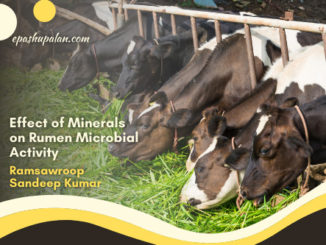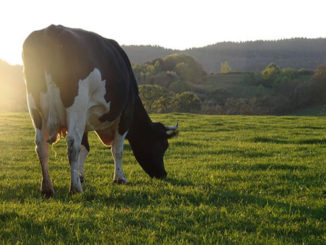Common salt eaten by animals is made up of two elements sodium and chloride and chemically it is sodium chloride. Both these elements are required by animals. There is 0.2 percent blood sodium in the body. Sodium is found in the body in bones, soft tissues and body fluids. Salt is also needed to maintain acidic and alkaline balance in the bodily medium. Salt helps in the absorption of amino acids and sugars in the intestine. The ability of muscles to contract depends on the amount of sodium.
Animals get salt from various food items and by feeding salt. Salt is also excreted from the body after being used in the metabolic processes in the body. For this reason, salt has been fed in the diet of animals since ages. Salt also creates a taste for the animals to eat food. Salt helps in the release of saliva and saliva encourages digestion of food. An acid hydrochloric plays important role in digestion and the chloride found in large quantities in common salt is helpful in its formation. Its excretion is less when salt is eaten in small amounts and high when eaten in large quantities. The excretion of salt from the animal body is controlled by the kidneys.
Symptoms of deficiency of salt in animal body
When there is a shortage of salt, the animal’s body reduces the excretion of sodium and chloride in the urine. If the animal does not get salt in the food for a long time, the animal starts eating and licking the clothes, wood and excreta etc. Through experiments, scientists have known that cows who are not fed salt, their appetite decreases in two-three weeks, due to lack of salt, the protein and energy of animal feed is not utilized properly. As a result, the body weight of the animal decreases and the milk production of the milking animals decreases. The symptoms of salt deficiency appear quickly and clearly in cows that give milk in large quantities because the salt comes out of their body through milk and to meet this deficiency, the animal does not get salt through the diet to fulfil it. It takes about a year for the animal to show the symptoms of salt deficiency.
Due to the lack of salt in the poultry diet for a long time, their growth rate is stunted and egg production decreases in the egg laying hens. Poultry also gets into the habit of plucking each other’s feathers for a sufficient amount of time in the diet.
| For subsistence | Sodium content |
| For non-milking animals | 1.67 g/100 kg weight |
| For milking animals | 4.22 g/100 kg weight |
| For weight gain | 1.56 g/kg weight gainers whose weight is 150-600 kg per day |
| For pregnancy | 1.54 g/day for 190-270 days of pregnancy |
| Atmosphere temperature: | 25-30°C 0.11g/100kg Weight
30°C 0.44g/100kg Weight
|
| Soluble salt content | (%) | Effect |
| 1000 | 0.1 | no side effects |
| 1000-2900 | 0.1-0.3 | Usually, no side effects but sometimes diarrhoea occurs |
| 3000-4900 | 0.3-0.5 | There is diarrhoea and there is a decrease in the amount of milk |
| 5000-6900 | 0.5-0.7 | This water should not be given, it has a lot of side effects on the lactating and pregnant animals. |
Some amount of salt is found in all the foods included in the diet. But more of it is found in the food items obtained from the sea and in the meat products. The remaining quantity of some requirement is fulfilled by mixing common salt in the grain or placing it in front of the animal to lick it in the form of a brick.
Animals in pasture get twice the amount of salt as compared to ordinary stall feeding. In the case of excessive rawness, more salt is obtained from the green fodder. Also, animals get more salt from silage.
A young cattle cow or buffalo usually requires about 13 grams of common salt in a day. Scientists have found that a lactating cow of 500 kg need about 30 grams of salt per day. The quantity of salt is mixed at the rate of 1.0 percent in the feed of cattle, buffalo, goats and sheep and at the rate of 0.5 percent in the feed of poultry.
Factors affecting the need for salt
- Diet has a major impact on the salt needs of animals.
- Another important reason is the level of sodium chloride and other mineral salts in the water and feed.
- Animals generally require 2-3 times more water than dry matter.
- Atmospheric temperature and humidity can be a major factor. In one research it has been seen that if there is 1.5 percent potassium in the food, then milk is produced in more quantity. The amount of potassium affects the amount of sodium and chloride.
- Animals lose a lot of sodium under heat stress.
The maximum amount of salt that the animal can consume depends on how much water the animal is receiving. Animals can tolerate even very high amounts of salt if there is an unlimited amount of water available. And the salt eaten in excess is passed out from the animal’s body through urine. On getting the amount of water, toxic effect is manifested even with only 2.2 per cent of the salt in the diet. Its main symptoms are excessive thirst and weakness of muscles. If more than 2.2 percent salt in the diet of poultry chicks, they are adversely affected. If the amount of salt in poultry food is 4, then even if unlimited amount of water is available, they start dying. The amount of salt fed in animal feed also depends on the sweat produced by the animal. It has been found by experiments that about 2 grams of sodium is lost after sweating the animal for one hour. Therefore, in order to get maximum production and to maintain the health of the animal, it is necessary that a balance should be maintained between the loss of salt from the animal’s body and the gain from the diet.





Be the first to comment